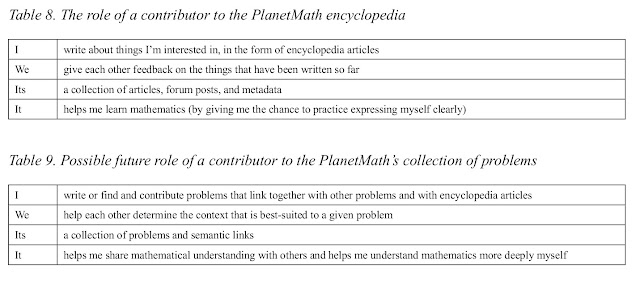«After many months of an apparently futile search, I dreamt of an equilateral pyramid. After awaking, I interpreted the dream as follows: An equilateral pyramid has four basic angles. My group work is based on four elements. They are interrelated, and my hypothesis is that they should be treated equally.»
~~
There is a similar breakdown due to Ken Wilber who writes about "I/We/Its/It" in
Wilber, K. (1997). An integral theory of consciousness. Journal of Consciousness Studies, 4(1), 71–92.
and another related sequence "Socialization/Externalization/Combination/Internalization" due to Nonaka and Takeuchi, in
Nonaka, I., & Takeuchi, H. (1995). The knowledge-creating company: How Japanese companies create the dynamics of innovation. New York, NY: Oxford University Press.
I used Wilber and Nonaka & Takeuchi material in a paper about how the different roles in education could be "deconstructed" and reorganized in a wiki-like way. Each of these "roles" is a little semiotic object that is meant to hook together with other related objects. A nice idea, in principle, but I think the weakness of this earlier work was that it remained "in principle".
In my thesis I extended I/We/Its/It with a fifth term, Context, similar to Cohn's Globe. The point of this extension is that it doesn't sit well for it to remain "just" theoretical. Things play out in real time at the contextual or global level. This is related to what Rasmus was tentatively calling "transcommunication" in a recent note, though I suggested "epicommunication" or "episemiotics".
~~
“I”: A single individual, “We”: The group, “It”: The theme or assignment the group is concerned with, and “Globe”: The environment which the gathering takes place in — both the direct surroundings, weather, timing constraints, and the whole universe.
~~
There is a similar breakdown due to Ken Wilber who writes about "I/We/Its/It" in
Wilber, K. (1997). An integral theory of consciousness. Journal of Consciousness Studies, 4(1), 71–92.
and another related sequence "Socialization/Externalization/Combination/Internalization" due to Nonaka and Takeuchi, in
Nonaka, I., & Takeuchi, H. (1995). The knowledge-creating company: How Japanese companies create the dynamics of innovation. New York, NY: Oxford University Press.
I used Wilber and Nonaka & Takeuchi material in a paper about how the different roles in education could be "deconstructed" and reorganized in a wiki-like way. Each of these "roles" is a little semiotic object that is meant to hook together with other related objects. A nice idea, in principle, but I think the weakness of this earlier work was that it remained "in principle".
In my thesis I extended I/We/Its/It with a fifth term, Context, similar to Cohn's Globe. The point of this extension is that it doesn't sit well for it to remain "just" theoretical. Things play out in real time at the contextual or global level. This is related to what Rasmus was tentatively calling "transcommunication" in a recent note, though I suggested "epicommunication" or "episemiotics".
~~
Often, groups steadily lean towards one of the four factors “I”, “We”, “It”, or “Globe”. This disturbs Living Learning. In educational groups, for example, in general the “It” is emphasized, whereas those groups fall short of the other three factors. - Philipp Bachmann, Theme-Centered Interaction. Ruth C. Cohn’s pattern language for facilitating groups (PLoP 2015 conference version)


"The I, as a psychic individual, can only be thought in relationship to we, which is a collective individual. The I is constituted in adopting a collective tradition, which it inherits and in which a plurality of I ’s acknowledge each other’s existence." - https://en.wikipedia.org/wiki/Individuation#Bernard_Stiegler
ReplyDeleteAnd:
ReplyDeleteThe we is also such a process (the process of collective individuation). The individuation of the I is always inscribed in that of the we, whereas the individuation of the we takes place only through the individuations, polemical in nature, of the I ’s which constitute it. - ibid.